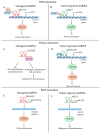Non-Coding RNAs in Cancer: Structure, Function, and Clinical Application
- PMID: 40002172
- PMCID: PMC11853212
- DOI: 10.3390/cancers17040579
Non-Coding RNAs in Cancer: Structure, Function, and Clinical Application
Abstract
We are on the brink of a paradigm shift in both theoretical and clinical oncology. Genomic and transcriptomic profiling, alongside personalized approaches that account for individual patient variability, are increasingly shaping discourse. Discussions on the future of personalized cancer medicine are mainly dominated by the potential of non-coding RNAs (ncRNAs), which play a prominent role in cancer progression and metastasis formation by regulating the expression of oncogenic or tumor suppressor proteins at transcriptional and post-transcriptional levels; furthermore, their cell-free counterparts might be involved in intercellular communication. Non-coding RNAs are considered to be promising biomarker candidates for early diagnosis of cancer as well as potential therapeutic agents. This review aims to provide clarity amidst the vast body of literature by focusing on diverse species of ncRNAs, exploring the structure, origin, function, and potential clinical applications of miRNAs, siRNAs, lncRNAs, circRNAs, snRNAs, snoRNAs, eRNAs, paRNAs, YRNAs, vtRNAs, and piRNAs. We discuss molecular methods used for their detection or functional studies both in vitro and in vivo. We also address the challenges that must be overcome to enter a new era of cancer diagnosis and therapy that will reshape the future of oncology.
Keywords: RNA; RNA detection; cancer; cancer diagnostics; cancer therapy; circRNA; lncRNA; miRNA; snRNA; snoRNA.
Conflict of interest statement
The authors declare no conflicts of interest.
Figures






Similar articles
-
Non-Coding RNAs in Breast Cancer: Intracellular and Intercellular Communication.Noncoding RNA. 2018 Dec 12;4(4):40. doi: 10.3390/ncrna4040040. Noncoding RNA. 2018. PMID: 30545127 Free PMC article. Review.
-
Promoter-based identification of novel non-coding RNAs reveals the presence of dicistronic snoRNA-miRNA genes in Arabidopsis thaliana.BMC Genomics. 2015 Nov 25;16:1009. doi: 10.1186/s12864-015-2221-x. BMC Genomics. 2015. PMID: 26607788 Free PMC article.
-
Epigenetic and Transcriptomic Regulation Landscape in HPV+ Cancers: Biological and Clinical Implications.Front Genet. 2022 Jun 14;13:886613. doi: 10.3389/fgene.2022.886613. eCollection 2022. Front Genet. 2022. PMID: 35774512 Free PMC article. Review.
-
Non-Coding RNAs as Mediators of Epigenetic Changes in Malignancies.Cancers (Basel). 2020 Dec 5;12(12):3657. doi: 10.3390/cancers12123657. Cancers (Basel). 2020. PMID: 33291485 Free PMC article. Review.
-
Differentially expressed non-coding RNAs and their regulatory networks in liver cancer.Heliyon. 2023 Aug 19;9(9):e19223. doi: 10.1016/j.heliyon.2023.e19223. eCollection 2023 Sep. Heliyon. 2023. PMID: 37662778 Free PMC article. Review.
Cited by
-
Role of MicroRNAs in Acute Myeloid Leukemia.Genes (Basel). 2025 Apr 11;16(4):446. doi: 10.3390/genes16040446. Genes (Basel). 2025. PMID: 40282406 Free PMC article. Review.
References
Publication types
Grants and funding
LinkOut - more resources
Full Text Sources

